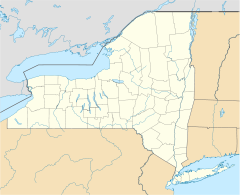- Chittenango Landing Dry Dock Complex
-
Chittenango Landing Dry Dock Complex
Location: Lakeport Rd. at Old Erie Canal, Sullivan, New York Coordinates: 43°3′36″N 75°52′26″W / 43.06°N 75.87389°WCoordinates: 43°3′36″N 75°52′26″W / 43.06°N 75.87389°W Area: 6.6 acres (2.7 ha) Built: 1856 Architectural style: Canal boat dry dock Governing body: State NRHP Reference#: 92000458[1] Added to NRHP: April 30, 1992 The Chittenango Landing Dry Dock Complex provided dry dock for canalboats on the old Erie Canal. The original complex was built in 1856 and abandoned after this section of the "enlarged" Erie canal was bypassed by the new barge canal in 1917. [2] The current restoration began in 1986 when the original dry docks were excavated, since then several buildings have been restored, one of which acts as a museum building.[2] The site was listed on the National Register of Historic Places in 1992. The listing includes six contributing structures over a 6.6-acre (2.7 ha) area.[1]
The site includes three dry dock bays.[3]
History
The Chittenango Landing dry docks were constructed in 1856 as part of the enlarged canal expansion of the original "Clinton ditch" canal. Due to the similarity in construction with other nearby dry docks in Newark, Albion, and Middleport the Chittenango docks were possibly constructed by the same contractor.[4]
The dry dock property was first purchased for $1400.00 from the Yates Estate in 1856 and changed ownership numerous times during its existence.[5]
After the enlarged canal ceased operation, the Chittenango Landing site was used for agricultural operations, the barn at the site was used to house horses, cows, and chickens through the first half of the twentieth century. The site's warehouse was also cut in half and moved, using block and tackle, to a new location behind the site's sawmill where it was used as an icehouse. The site was also subject to scavenging of wood from its building and abandoned barge, the Beech Nut. In 1950, stones were removed from the dry-docks’ walls for use in construction of the New York State Thruway. Two canal era residences still remained on the property as late as 1972.[6]
References
- ^ a b "National Register Information System". National Register of Historic Places. National Park Service. 2009-03-13. http://nrhp.focus.nps.gov/natreg/docs/All_Data.html.
- ^ a b Chittenango Landing Musuem. ""Chittenango Landing Musuem brochure"". http://www.chittenangolandingcanalboatmuseum.com/visit/docs/ppf.pdf. Retrieved 2011-20-11.
- ^ Christine B. Lozner (January 24, 1992). "National Register of Historic Places Inventory/Nomination: Chittenango Landing Dry Dock Complex". http://www.oprhp.state.ny.us/hpimaging/hp_view.asp?GroupView=3955. Retrieved 2010-02-21. and Accompanying seven photos, from c. 1875, c. 1913, 1989, and 1991
- ^ Daniel H. Weiskotten (November 1991). ""Dry Docks of the Erie Canal - 1817-1917"". http://freepages.history.rootsweb.ancestry.com/~nc99usgw/drydocks.html. Retrieved 2011-20-11.
- ^ Daniel H. Weiskotten (1991). ""History of Chittenango Landing Dry Dock"". http://freepages.history.rootsweb.ancestry.com/~nc99usgw/clcbm.html. Retrieved 2011-20-11.
- ^ Blizard, C.; Schuster, R. (2003). ""AN EXAMINATION OF HOW SITE HISTORY IS PRESENTED TO SCHOOL GROUPS AT CHITTENANGO LANDING CANAL BOAT MUSEUM"". Proceedings of the 2003 Northeastern Recreation Research Symposium. Newtown Square, PA: USDA Forest Service. pp. 34-41. http://www.fs.fed.us/ne/newtown_square/publications/technical_reports/pdfs/2004/317papers/blizard317.pdf. Retrieved 2011-21-11.
U.S. National Register of Historic Places Topics Lists by states Alabama • Alaska • Arizona • Arkansas • California • Colorado • Connecticut • Delaware • Florida • Georgia • Hawaii • Idaho • Illinois • Indiana • Iowa • Kansas • Kentucky • Louisiana • Maine • Maryland • Massachusetts • Michigan • Minnesota • Mississippi • Missouri • Montana • Nebraska • Nevada • New Hampshire • New Jersey • New Mexico • New York • North Carolina • North Dakota • Ohio • Oklahoma • Oregon • Pennsylvania • Rhode Island • South Carolina • South Dakota • Tennessee • Texas • Utah • Vermont • Virginia • Washington • West Virginia • Wisconsin • WyomingLists by territories Lists by associated states Other Categories:- Historic districts in New York
- Industrial buildings and structures on the National Register of Historic Places in New York
- Buildings and structures completed in 1856
- Buildings and structures in Madison County, New York
- Erie Canal
- Madison County, New York Registered Historic Place stubs
Wikimedia Foundation. 2010.

